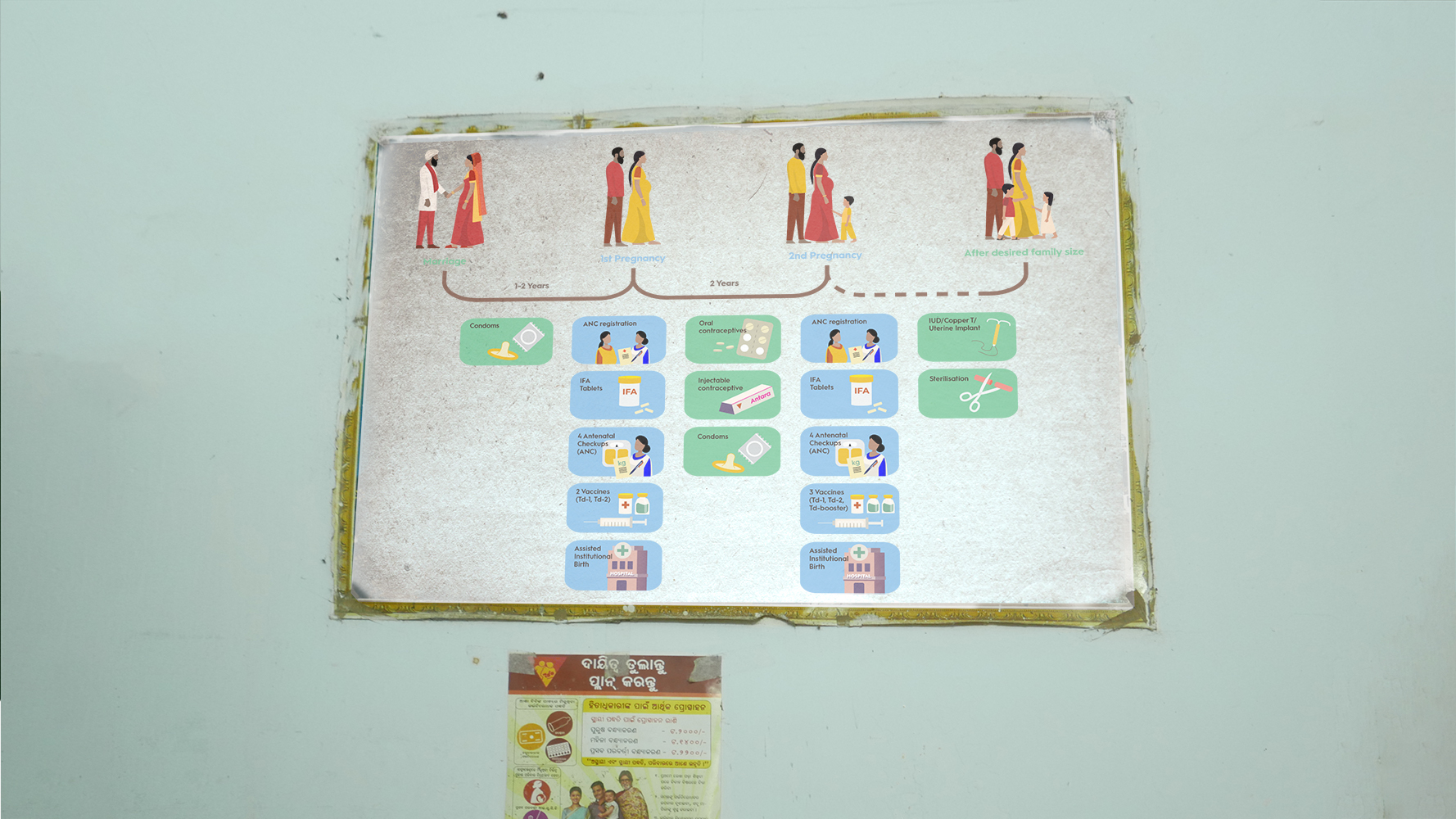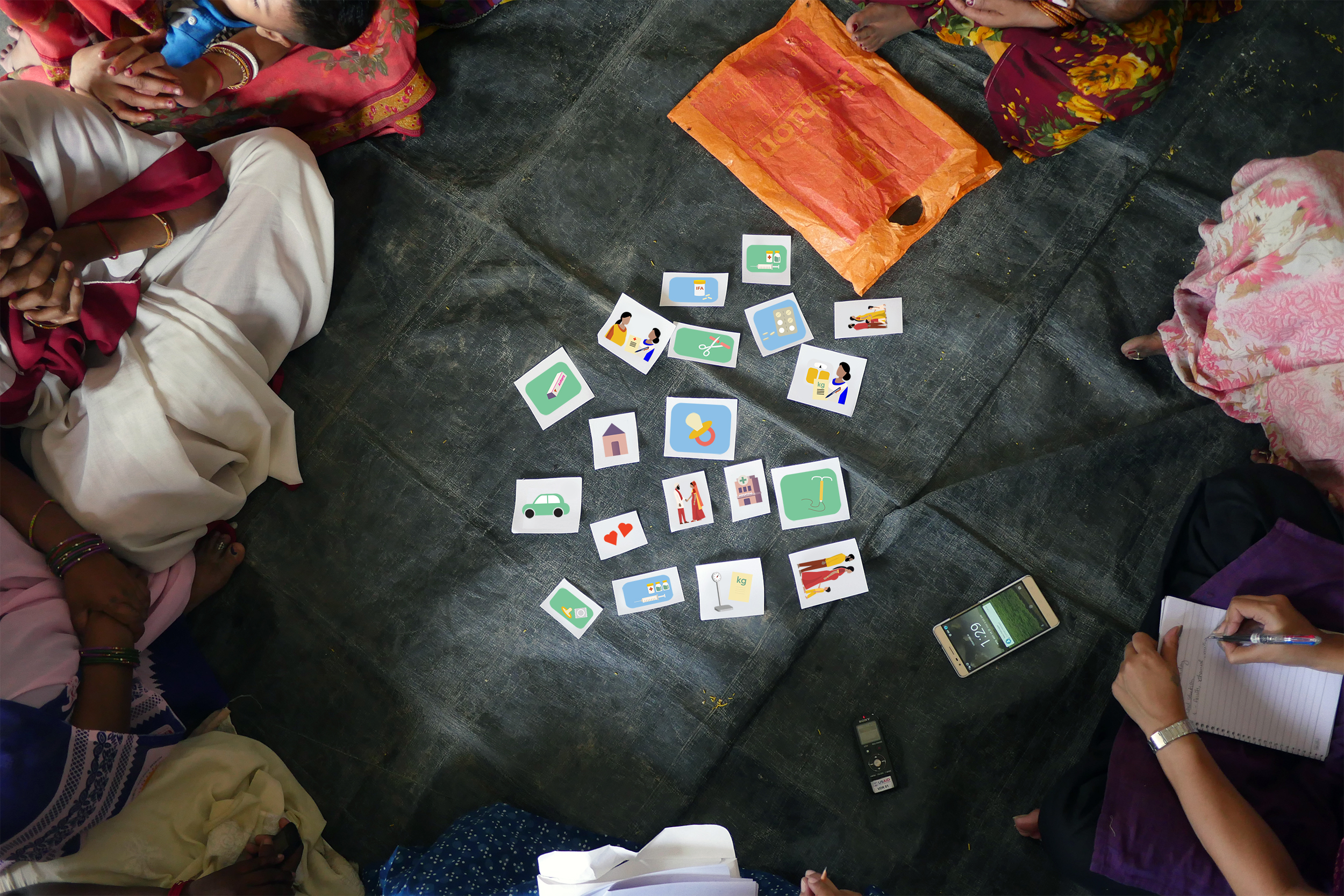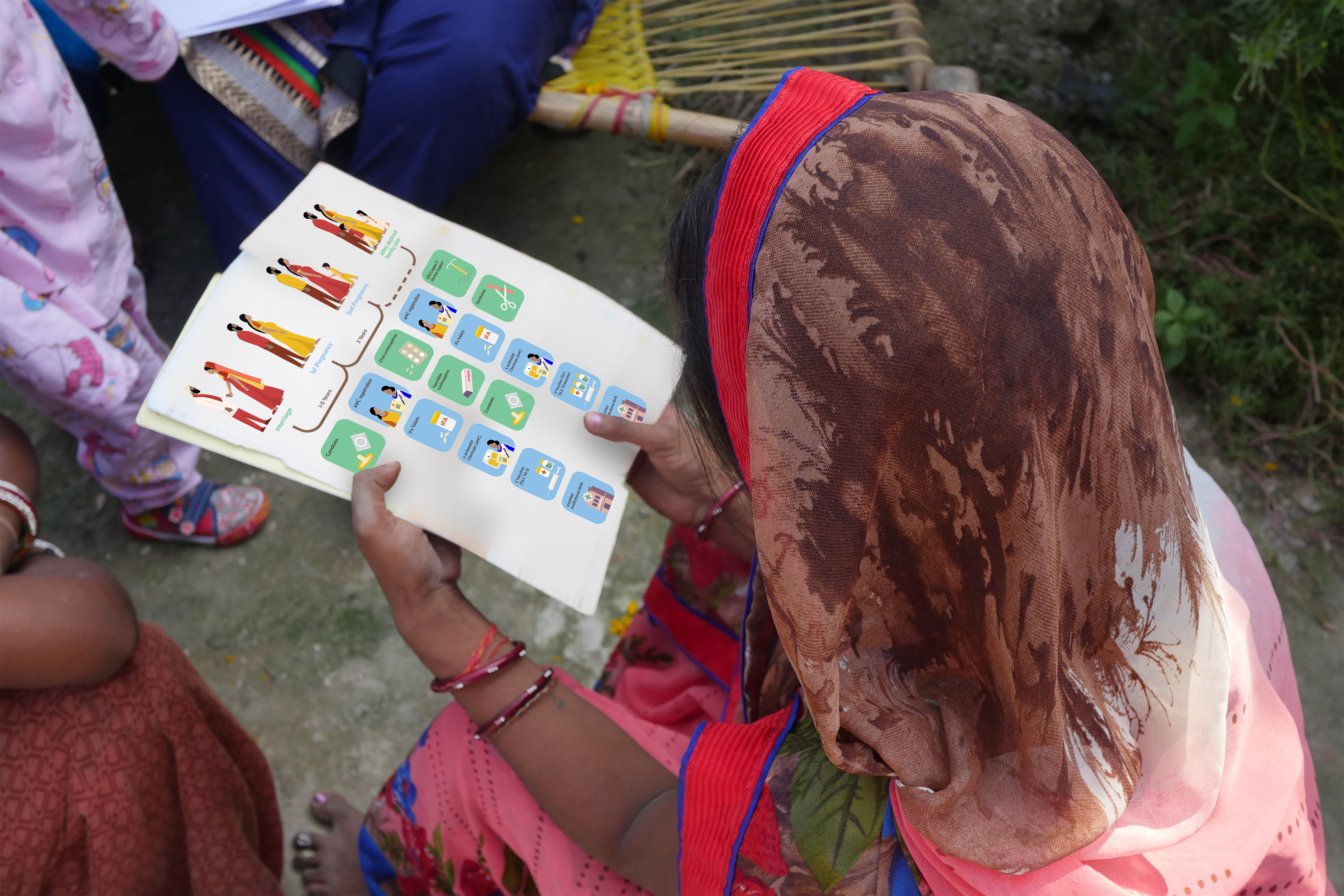10.14 Prototyping the Future Family Tool
10.14.1 Selection, Objectives & Recruitment The main considerations for prototyping were:
- Materials and amount development to reach required fidelity.
- Distance to participant(s) and ability to leverage existing relationships.
- Complexity of solution and relation to existing ASHAs work.
Based on this criteria, the Future Family Tool was the best fit:
- The materials could be developed quickly based on existing information.
- The contacts are already in place and are likely to be working with Newly Married couples.
- The solution is very similar to a suggestion from participants in co-design.
The objective of prototyping was to understand the acceptability of the tool from both ASHAs and newlyweds, to explore options for contents and activities, and then to iterate the concept. The tool was printed for ASHAs to use with newlyweds. Medium fidelity prototypes are given to ASHAs to test with couples in March and April 2021.
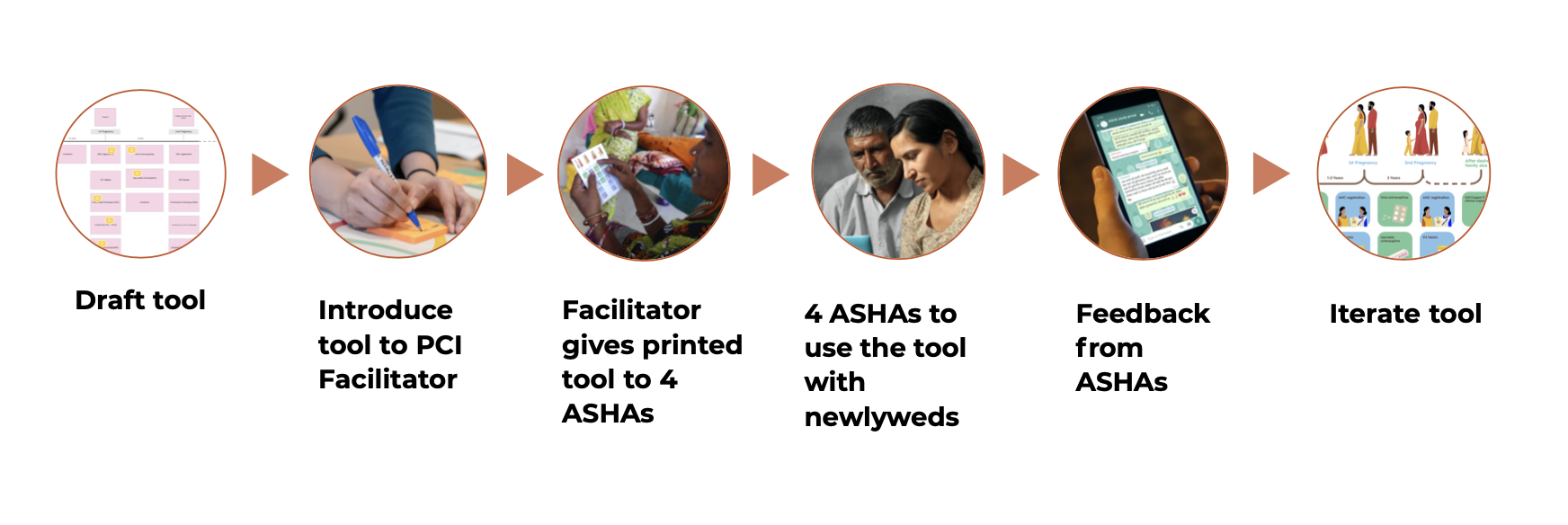
Draft tool - Based on the idea template, rapid feedback, and reflection on data, the concept was iterated and a simple visual was drafted to prototype the key concepts. The visual allows ASHAs to try out how it might work in practice without developing a fully polished version with all aspects of the concept included. This is a simple two sheet A4 which can be printed and used as a discussion guide with newlyweds. On the left is the initial draft, and on the right the simple visual with icons:
Process from introduction to use - The PCI Facilitator was first trained in the tool, and then they trained 4 ASHAs in the use of this tool, and each ASHA used the tool with 1 newlywed couple or family in their village. After this each ASHA was interviewed to gather feedback and the tool was iterated based on this.
Feedback - The feedback was gathered through Whatsapp and phone conversations with each ASHA, as well as a group call with the ASHAs. They shared about the benefits, difficulties, and future desires for a tool like this. All the ASHAs requested a personal copy of the tool to keep.
10.14.2 How the Future Family tool works
The Future Family tool prototype has two parts that the couple fills during the first meeting:
The first part of the tool is the women’s health service timeline that has a visualised timeline of all SRH and MCH services that women can avail at different stages of her reproductive health journey. ASHAs can use it to explain various services in chronology to the couple and the couple can refer to this tool for reference and recollection in the ASHA’s absence.
The second part of the tool is an empty timeline marked only with pregnancies. It is meant to be used by the couple to create their own timeline by filling in information as per their choices of family size and birth spacing methods, as well as non-health goals/aspirations that they might wish to achieve alongside the growth of their family.
The Ritualization Strategy behind the tool: The strategy behind the tool can be explored through the Ritualization Strategy Framework, although the tool targets the behaviour of Family Planning, it does so by leveraging the connections between the four elements:
● The tool leverages ASHAs existing visit after marriage to introduce a tool, or artifact, to the household. The tool will be revisited on an ongoing basis, and revised as needed. ● As the husband has the decision making power in the relationship, the tool targets his motivation for financial stability. ● Furthermore the tool, as an artifact in the household, also has the effect of involving and educating the Mother-In-Law.
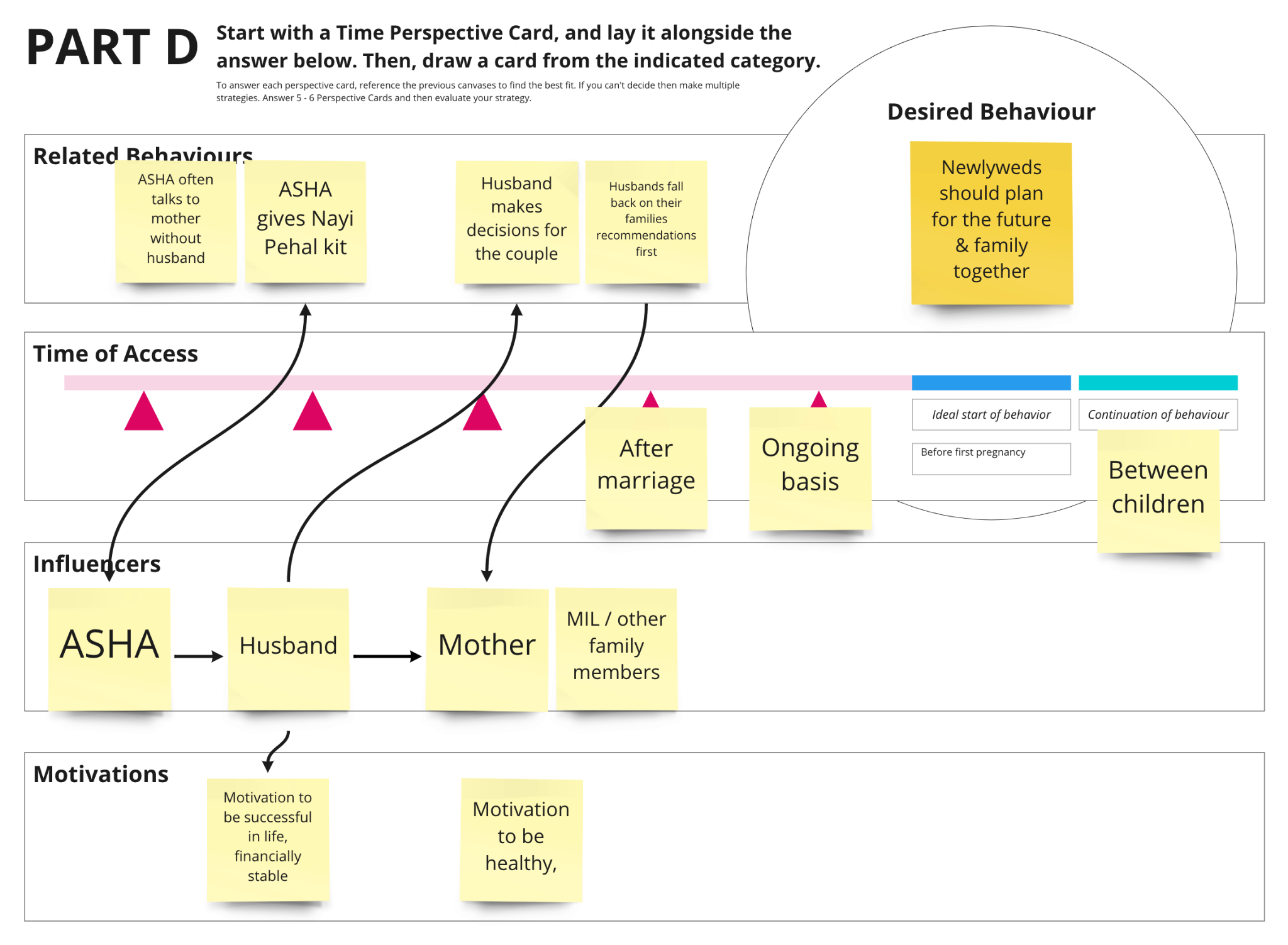
See Annex for filled template and Ritualization Strategy Framework Guide.
10.14.3 Prototyping results
How ASHAs felt about the tool:
- It allowed thoroughness in narrating advice
- Tool held the attention of the couple and also engaged other family members because it is visual
- They felt it will allow higher retention of advice for couples since they can see the advice on the tool anytime after it has been given to them.
- All ASHAs we tested with asked for extra personal copies of tool to keep with themselves ● ASHAs felt a calendar or wall hanging would be a good form for the tool so that it remains intact and in use after distribution.
How the couples used the tool:
- The 2nd part of the tool was filled by the woman in all the test couples
- Continuing education was mentioned in early years by women
- All respondents described contraceptive choices or in places mentioned that ASHA should suggest at transition points what she should use.
- They were unable to imagine and articulate non health aspirations around attaining new assets or future life plans that may be considered couple goals.
Included images - Family discussing the template & Filled template from couple.


Untested features of the tool for further exploration:
While this concept has many good ideas, it is still a complex solution with many moving pieces. As testing is focusing on the ASHA-Newlywed interaction, there are several parts of the concept are not included in this round, for example:
The possibility of leaving the tool as an artifact that supports other rituals and behavior changes over time.
Other formats of Part 2 other than fill in the blank.
Further iterations could include stickers or other components.
How the tool improves the ASHAs advice and therefore better responds to the unique context the newlyweds present.
Helping the newlyweds identify specific influencers that may be supporters or barriers to specific behaviors.
The possibility of ASHAs sharing behavior change strategies amongst themselves.
Future Considerations:
While the paper prototype was successful, it isn’t durable enough for long-term use. In the next iteration, it could be made more durably or even be a digital tool.
The tool proved useful and engaging around Family Planning, but could use more emphasis on aspirations and other types of planning. The same timeline could also be used for other topics entirely, such as nutrition.
The training for ASHAs should include more emphasis on engaging the husband, while the other family members engaged more easily than expected. They also need training on how often and in what ways to revisit the tool, especially in integrating with their existing rounds. Image description:
Modular aspirational elements, such as house or car, to build a story
Poster to be displayed at home to facilitate conversations
Calendar for display with an accompanying private part
A book format, that is more durable and portable

